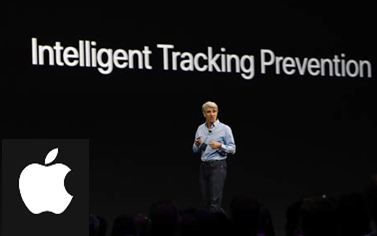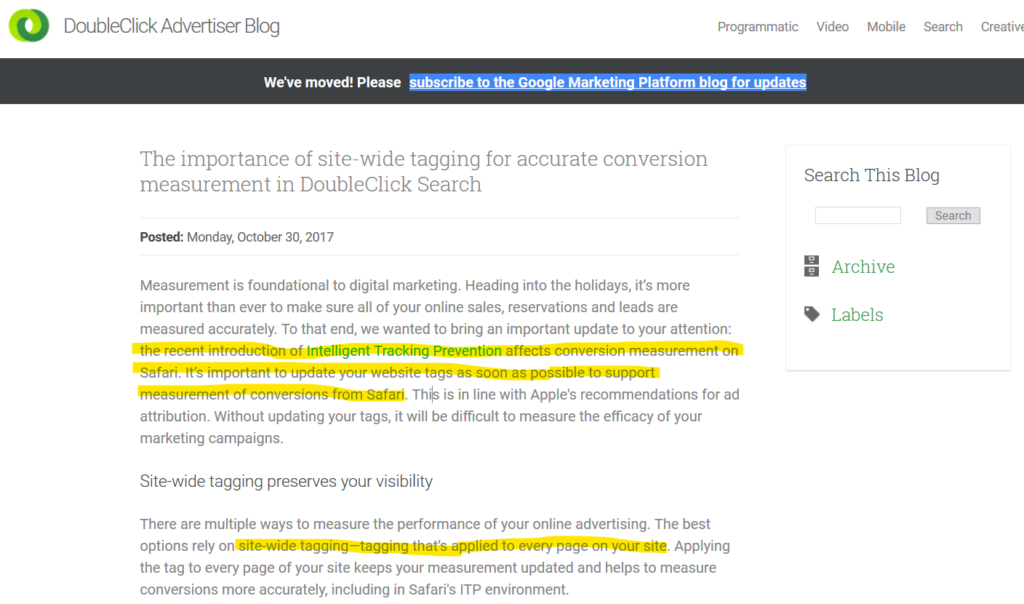
In September of 2018, Apple released Safari 12 and updated its Intelligent Tracking Prevention 2.0 as a follow-up privacy enhancement for their customers. The newer ITP 2.0 update was even stricter than ITP 1.0 (released in September of 2017) going from expiring 3rd party tracking cookies in 24 hours to immediate expiration, i.e. effectively blocking all of them. The ad tech and ad network industry is rightfully concerned about this existential threat to their way of doing business. However, it should not have been a surprise to them.
For digital marketers and particularly advertisers, canny moves by Big G are taking advantage of the “crisis” situation. With long-time business tentacles deep and wide, the intrinsic value and security of advertisers’ campaign and Web site behavioral data should be of particular concern. Consider how data once captured can be leveraged by and between paid media business (search, display ad network), ad stack (ad server, DSP, DCO) and the site-side stack (search console, analytics, attribution, optimization and tag management).
Super Basic Overview of 3rd Party Cookie Tracking
To recap, 3rd party tracking cookies are the kind of cookies that are used by ad tech/networks all or in part for analytics and optimization. These cookies are different from the 1st party tracking cookies used by Web sites that are actually visited by users to authenticate and personalize the user experience (custom content), e.g. ecommerce sites and social networks. By contrast, 3rd party cookies are delivered to the browser by another and different Web server from the Web site domain that the user is accessing, e.g. Ford ads on the New York Times Web site. This is often called cookie “context.” Under the auspices of convenience, AdWords leverages an internal “link” to Big G analytics and the Big G ad server (DoubleClick/DART for Agencies/DFA/DCM/Big G Ads).
To put the tracking impact of ITP 2.0 on analytics and targeting in perspective, as of the time of this writing, Safari 12 (ITP 2.0) represents about 15-20% of all Web site visits for a typical brand with the prior Safari 11 (ITP 1.0) representing another 15-20%. That puts a combined total of 35-40% of Web site visits. In terms of unique visitors to a Web site, this is probably more like 15-20% that are at risk of being miscounted, misreported and therefore highly in-actionable. Maciej Zawadinski one of the founders of Piwik/Matomo, wrote an informative and objective piece on ITP and tracking.
For advertisers, it is also likely that there is a very distinct sociodemographic skew to this hard-to-reach and highly perishable user segment. The group tends to be higher education, more male and higher income. Think along the lines of an oldie but a goodie: ComScore’s Natural Born Clickers from 2007 updated in 2009.
Big G’s Timing and Blaming the Victim
Although 3rd party cookie tracking has been getting worse over the years, there has been a paucity of published research on this far-reaching problem. Despite having the biggest advertiser and publisher ad server market shares, Big G has nothing to say about how reliable their 3rd party tracking cookie really is in practice. Publishers and agencies are left to figure it out themselves though most do not have the time or resources. If the industry has such research it is sequestered at an account-level or within a QA group as it is unflattering at best and devastating at worst.
In one published study, programmatic tech company Digilant observed in 2012 that 3rd party ad cookies degraded quickly: by 43% in the first seven days and by 75% within twenty-eight days. That should not be a surprise with ad networks, ad servers, other analytics/targeting platforms’ cookies increasingly being blocked, blacklisted and actively deleted by users.
Instead, on Monday October 17, 2017 Big G proclaimed through the now retired DoubleClick brand’s blog:
The two options offered (click the above link and scroll down) are:
- Use the fake gtag.js (see:GTM disguised as a Floodlight)
- Avoid any such pretense and use the naked GTM with the easy linking capability
The instructions to expand their presence and put it up on *all* pages almost seem helpful.

The inconvenient truth for many digital advertisers, their media agencies and 3rd party cookie-reliant ad servers/analytics as a result of the miscounting is that important digital metrics are severely compromised. Ad tech company Flashtalking regularly quantifies and publishes research on the inaccuracy of ad metrics can be that depend on 3rd party tracking cookies. Most recently, they bravely put user cookie rejection rate at 47%! For individual users they estimate 25% are rejecters. That means that when it comes to analytics and optimization, reach and viewthrough conversions are effectively overstated while frequency is understated. For more information, see Viewthrough.org’s recent post, 3rd Party Tracking Weakening, Viewthough Impacted.
What to Do About It?
Digital marketers do have options to improve both targeting and analytics without risking more Web site behavioral data leakage to hidden players in the ad tech stack. Fortunately for advertisers these days there is a new breed of ad server that is more transparent and uses more reliable tracking methods: Flashtalking, TrueEffect and possibly Sizmek. Are there others out there? Let TOTSB know!
